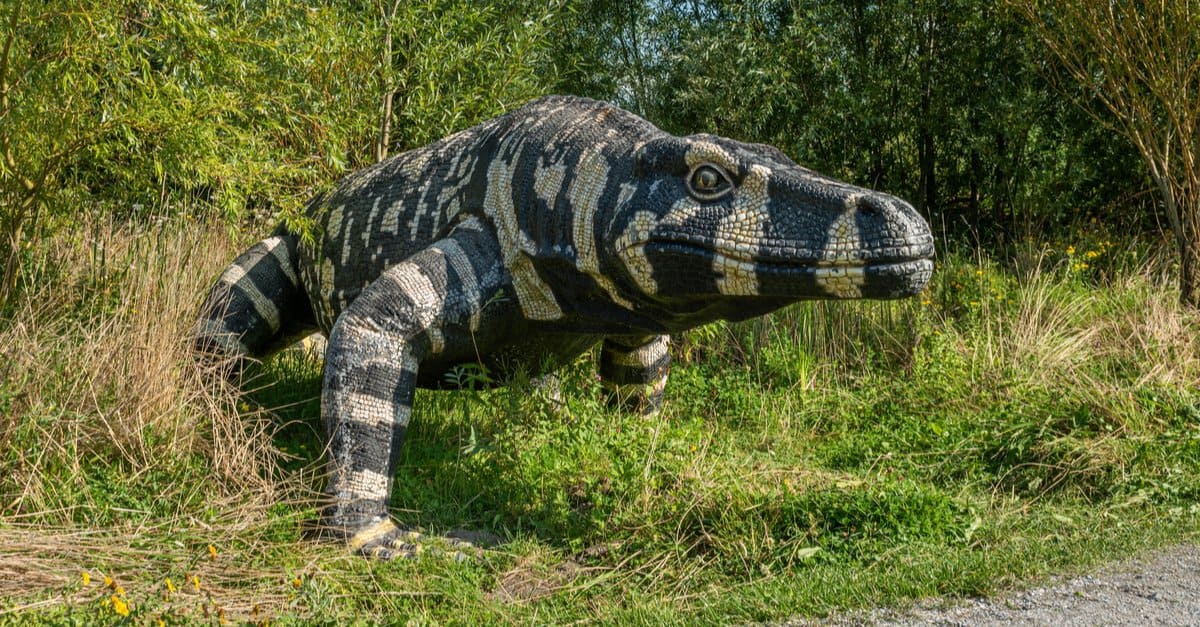Monitor lizards are very large reptiles that can vary in size and aggressiveness. At present, the Komodo dragon is the largest extant lizard on the planet today. It is capable of preying on deer and has even attacked humans. However, they were not always the largest lizard to walk the planet. In the not-too-distant past, a monstrous monitor lizard 10x bigger than a Komodo dragon roamed the Earth, and it may have lived alongside humans.
Let’s examine the massive reptile known as Megalania (Varanus priscus) and see how large it was when it lived and what drove it to extinction!
What Lizard Was 10 Times Bigger Than a Komodo Dragon?
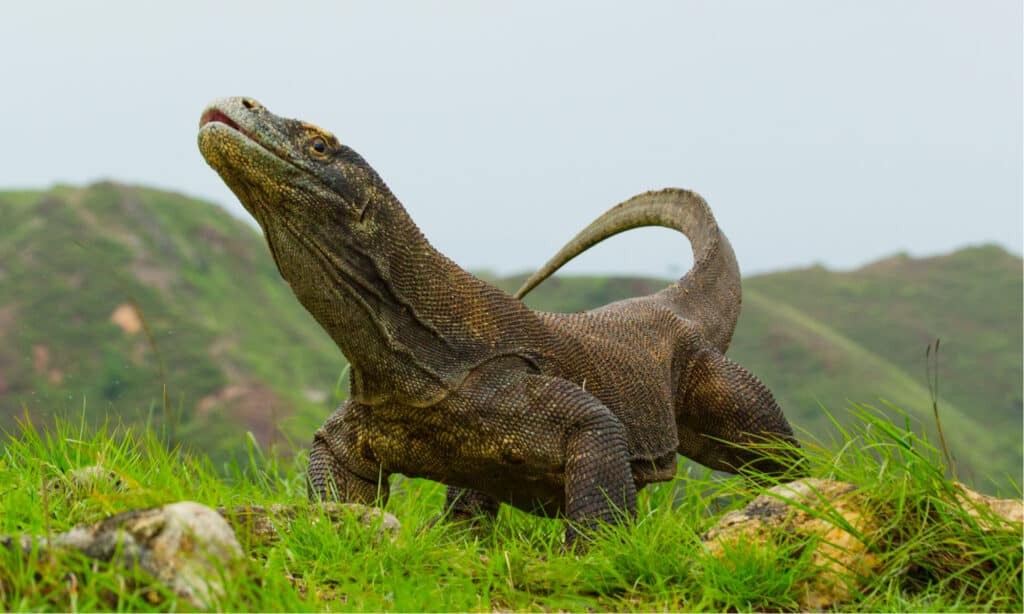
Komodo dragons can weigh over 300 pounds!
©GUDKOV ANDREY/Shutterstock.com
Megalania is the common name for the Varanus priscus, an extinct and massive monitor lizard. It’s believed that Megalania was the largest monitor lizard of all time.
Based on the data gathered from fossils, it’s hard to determine the lizard’s size with any certainty. One paleontologist named Ralph Molnar believes that Megalania could have grown anywhere between 11.5 feet and 23 feet long and weighed up to 4,277 pounds. Others say it was perhaps 18 feet long and at least 1,260 pounds or more. No matter how we look at this reptile, it was very large.
However, there is a lot of room for error in those estimates as the available fossils are described as fragmentary.
The Megalania is often depicted as being very similar to and larger than the Komodo dragon. The average Komodo dragon weighs about 150-300 pounds and grows about 6.6 feet long, including their powerful tails.
So, not only was this lizard twenty times heavier than the average Komodo dragon, but it was also ten times bigger than the largest Komodo dragon that weighed 365 pounds and grew over 10 feet long!
The Megalania could have been a massive, terrifying creature that would move surprisingly fast on land. Komodo dragons can move at about 11 mph. If the Megalania could move at that speed, it would have been capable of swift, brutal attacks. However, some studies suggest that its max speed was closer to seven miles per hour. That was enough to hunt some creatures but not enough to conquer them all, as we’ll show you.
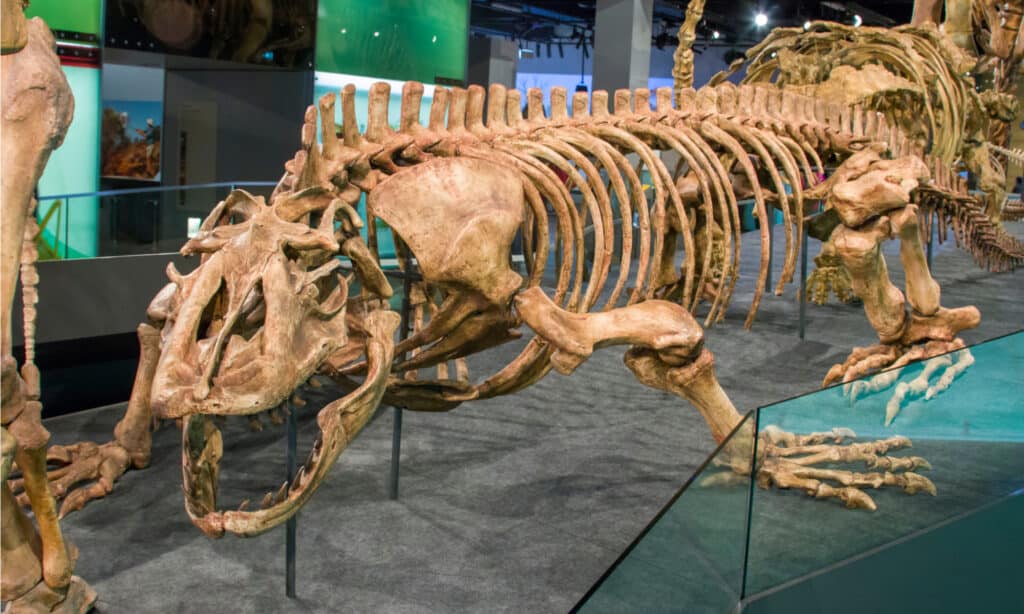
The cast fossil of Megalania from Queensland, Australia, in Melbourne Museum. It is an extinct giant goanna or monitor lizard.
©Danny Ye/Shutterstock.com
How Was Megalania Similar to Modern Monitor Lizards?
As we’ve already said, scientists believe that Megalania was very similar to the Komodo Dragon. If that is true, we can glean a fair amount of information about the lizard. For one thing, Komodo dragons use a unique form of salivary venom that helps exsanguinate and induce shock in prey.
The venom of a Komodo dragon is not the same as snake venom. They don’t bite foes once and wait for them to die. Instead, Komodo dragon venom results in anticoagulation, increasing the blood loss of foes. Their attacks still necessitate a vicious assault by the lizard to be effective. Nevertheless, it seems likely that the Megalania used the same attacking methods as its modern family member.
Komodo dragons often creep up close to prey and then attack. They will use a brutal combination to kill their foes. Often, Komodo dragons use their incredibly sharp albeit short teeth to rip open their prey. These lizards don’t have a powerful bite, but they can use a hold-and-pull technique to bite and tear their prey even without a strong jaw.
If we applied these concepts to a much larger monitor lizard, these attacks would become even more potent and frightening. Such a lizard would have an even longer, heavier tail to drive prey to the ground. Also, the Megalania would have a larger body with which to pin creatures while delivering vicious bites.
All told, the Megalania was an even more terrifying version of the Komodo dragon. There’s also some evidence that it had encounters with humans many years ago.
Did Megalania Live with Humans?
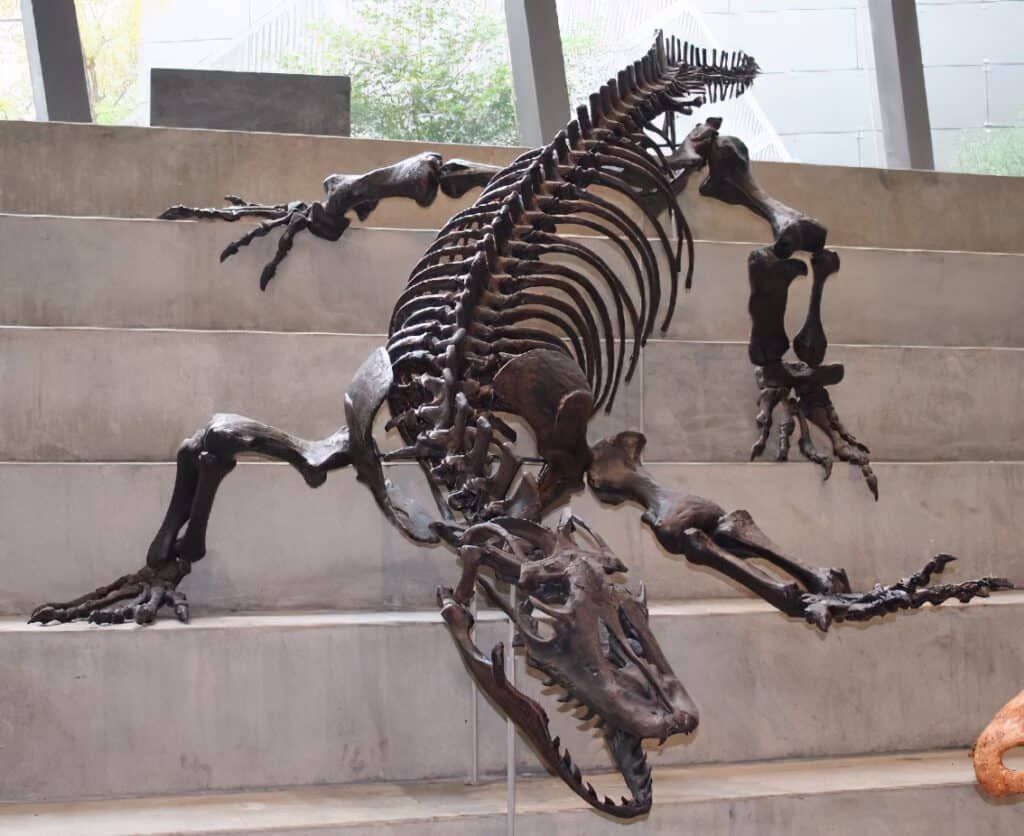
Based on fossil records, Megalania lived at the same time as early humans.
©Cas Liber / public domain – Original
The fossils of Megalania were found in eastern Australia, not too far from the Indonesian islands where Komodo dragons live today. The interesting thing about these fossils is their age. Instead of being millions of years old, the youngest Megalania fossils show that the lizards roamed Australia as few as 50,000 years ago.
Interestingly, the first human fossils that have been found in Australia are believed to be anywhere between 47,000 and 60,000 years old. That means that Megalania and other megafauna lived on the continent at the same time as the earliest humans.
As humans migrated to this part of the world, they would have been greeted by some of the most dangerous animals that live in Australia. They would have also had to contend with massive animals like Megalania, Diprotodon (a large marsupial), and the Thylacoleo (a marsupial lion).
Megalania likely had encounters fed on some of these animals along with smaller mammals, birds, and other wildlife. Given the Megalania’s size, aggressiveness, and proximity to humans, the lizard 10x bigger than the Komodo dragon could have killed humans.
Why Did Megalania Go Extinct?

Humans would be at the center of how Megalania went extinct.
©maradon 333/Shutterstock.com
Humans most likely played a larger role in making the Megalania go extinct. While evidence of humans killing these animals is sparse, the truth is that many of the megafaunas that roamed Australia started disappearing at the same time that humans arrived.
Early Australians may have encountered these animals and recognized them as a threat. It’s even possible that humans were killed by this great lizard. Human beings are great at recognizing threats and coming up with ways to kill them, and that’s probably what happened in this case.
Either humans started to wipe out their major sources of food by hunting, or they hunted down the lizard. Whether they did this solely to eliminate a threat or to eat the Megalania is unclear. However, armed humans could outrun and outlast these creatures on land, giving them an advantage if they were careful during the hunt.
The largest monitor lizard to live in Australia was similar to a Komodo dragon but also much larger. We don’t know for certain how large it was, but we do know that it was powerful, potentially venomous, and probably killed off in some way by early Australians.
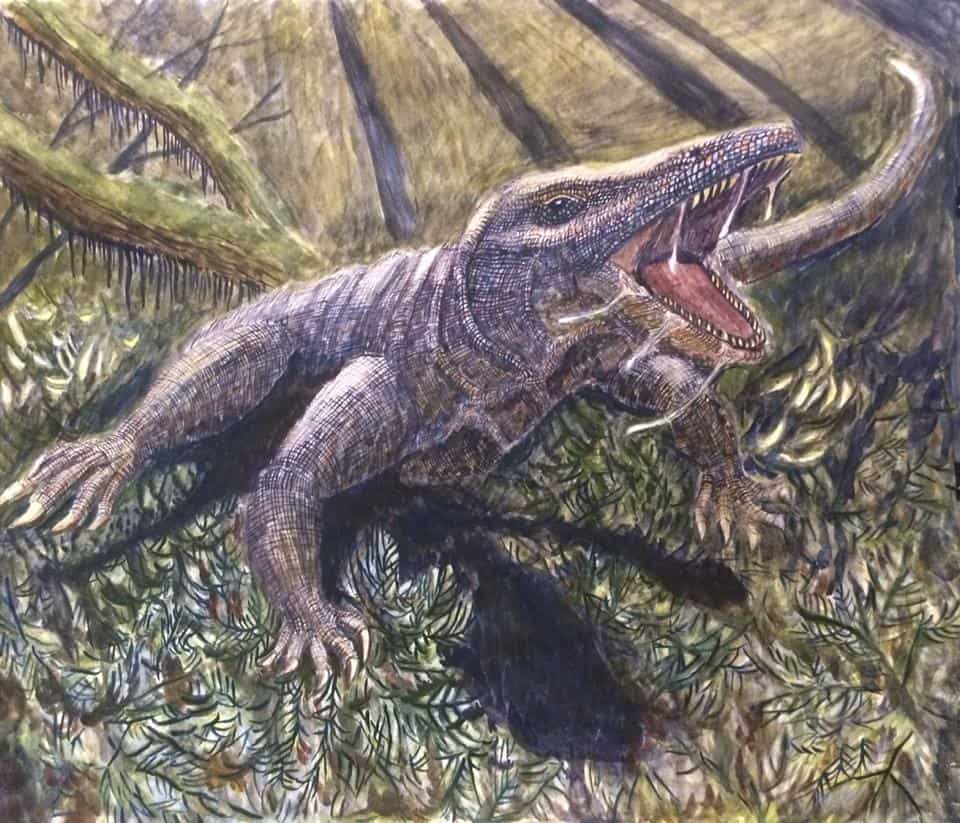
Mainly feasting on mid-sized to large animals, Megalania would have been a carnivore.
©By Xapaga tocnxnpo – Own work, CC BY-SA 4.0, https://commons.wikimedia.org/w/index.php?curid=49370495 – Original / License
What Did Magalania Eat?
Megalania was a giant predator. This formidable creature would have preyed on large mammals such as kangaroos, wombats, wallabies, and dingos. It also would have captured other reptiles like snakes and lizards for lunch and, when it was lucky, birds too. Megalania had an impressive set of sharp teeth, which it used to tear into flesh with ease. Its powerful tail could be swung from side to side with force, making it capable of taking down larger animals if needed.
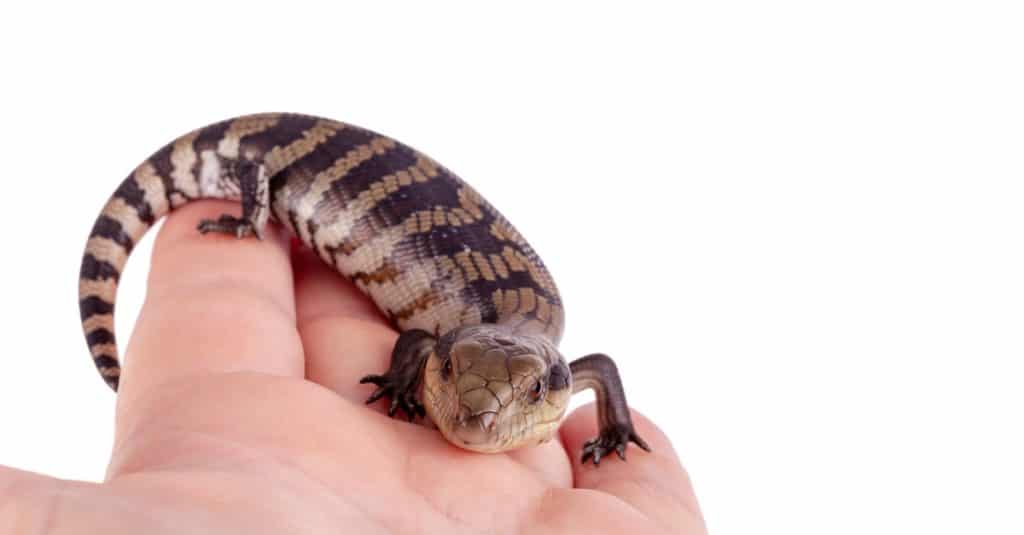
Eastern Skinks are common around the gardens of Australia.
©EdwardsMediaOnline/Shutterstock.com
What Do Modern Modern Komodo Dragons Eat?
The typical diet of a large Komodo dragon consists mostly of carrion (dead animals) and smaller reptiles, such as snakes and lizards. They also eat rabbits, mice, and rats if they come across them. They also have been known to consume larger prey like deer, pigs, goats, and sometimes even smaller dragons! On occasion, they will scavenge for eggs or any small invertebrates that may be available in their habitat. The Komodo dragon has an incredibly powerful sense of smell which allows them to detect food from miles away.
Other Australian Lizards
Australia is a diverse continent with many different species of lizards living in its various environments. The most well-known lizard native to Australia is the garden skink. Other types of lizards that live in Australia are geckos, dragon lizards, and blue-tongued lizards. These reptiles vary in size from very small to quite large and come in a range of different colors and patterns. They can be found all over Australia, from tropical rainforests to arid deserts. Many Australian species have adapted features such as sticky toes for climbing trees or long tails for balance when moving quickly across hot desert sands.
Thank you for reading! Have some feedback for us? Contact the AZ Animals editorial team.

